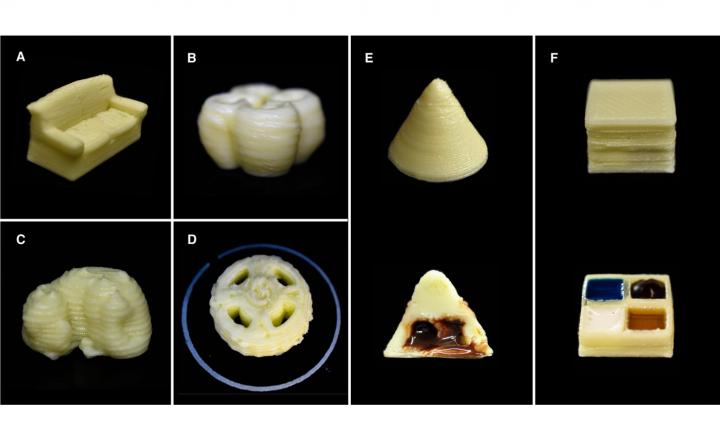Additive free, multimaterial 3D printing is achieved for milk-based products without temperature control

Credit: SUTD
Researchers from the Singapore University of Technology and Design (SUTD) developed a method to perform direct ink writing (DIW) 3D printing of milk-based products at room temperature, while maintaining its temperature sensitive nutrients.
3D printing of food has been achieved by different printing methods, including the widely used selective laser sintering (SLS) and hot-melt extrusion methods. However, these methods are not always compatible with temperature-sensitive nutrients found in certain types of food. For instance, milk is rich in both calcium and protein, but as these nutrients are temperature sensitive, milk is unsuitable for 3D printing using the aforementioned printing methods which require high temperature. While the cold-extrusion is a viable alternative, it often requires rheology modifiers or additives to stabilize printed structures. Optimizing these additives is a complex and judicious task.
To tackle these limitations, the research team from SUTD’s Soft Fluidics Lab changed the rheological properties of the printing ink and demonstrated DIW 3D printing of milk (refer to image) by cold-extrusion with a single milk product – powdered milk. The team found that the concentration of milk powder allowed for the simple formulation of 3D-printable milk inks using water to control the rheology. Extensive characterizations of the formulated milk ink were also conducted to analyse their rheological properties and ensure optimal printability.
“This novel yet simple method can be used in formulating various nutritious foods including those served to patients in hospitals for their special dietary needs,” said the lead author and Ph.D. candidate from SUTD, Mr Lee Cheng Pau.
“Cold-extrusion does not compromise heat-sensitive nutrients and yet offers vast potential in 3D printing of aesthetically pleasing, nutritionally controlled foods customized for individual requirements,” added Assistant Professor Michinao Hashimoto, the principal investigator of the study.
This research was published by RSC Advances, a leading journal that encourages high quality, well conducted studies which contribute to the advancement of chemistry and its applications. Rahul Karyappa, a research fellow at SUTD, also participated in this project.
###
Media Contact
Jessica Sasayiah
[email protected]
Original Source
https:/
Related Journal Article
http://dx.




